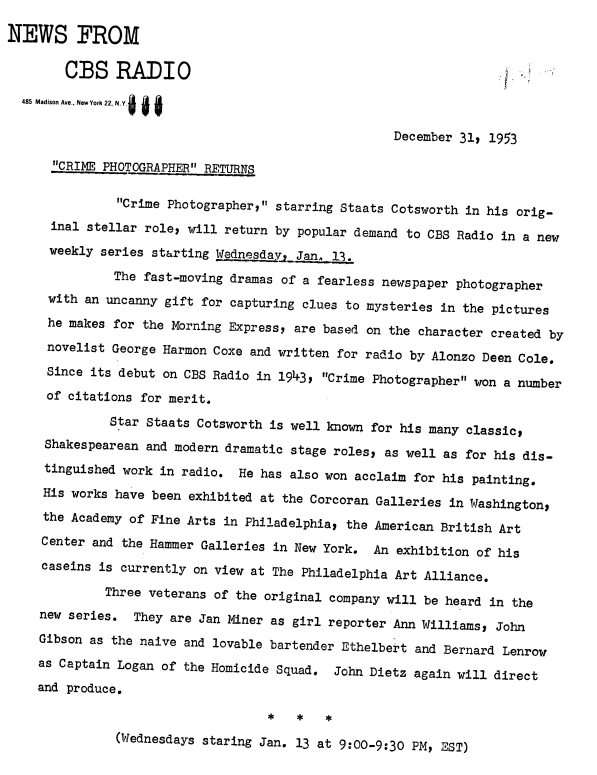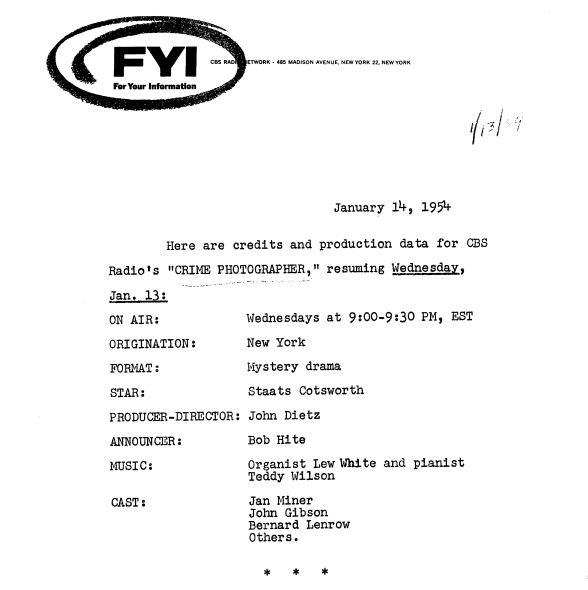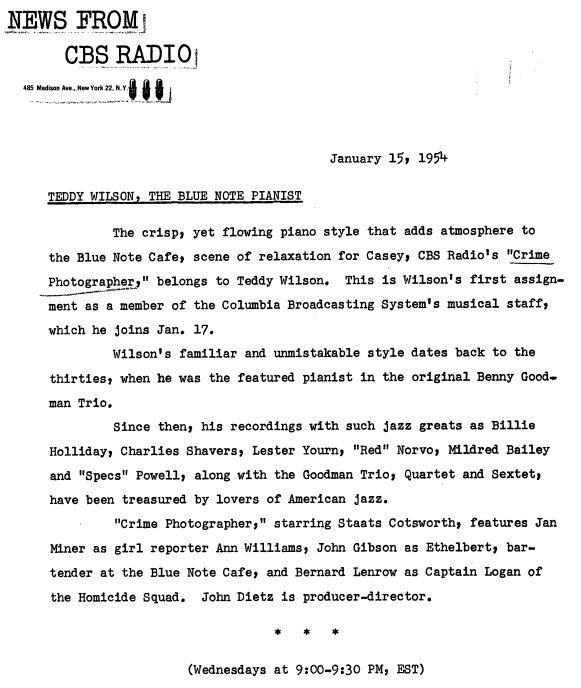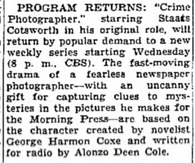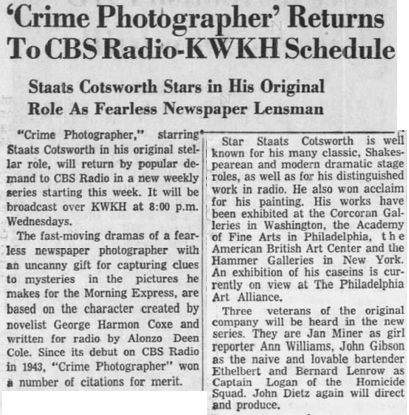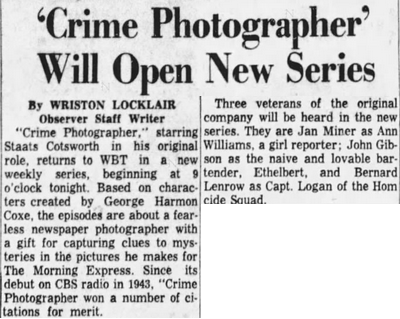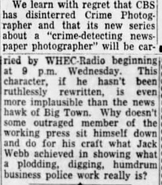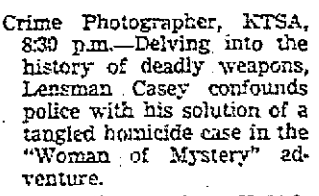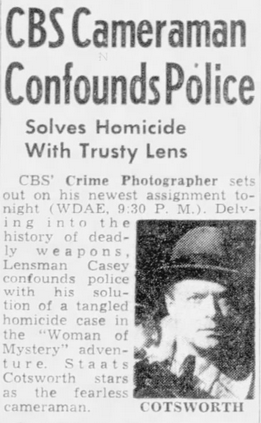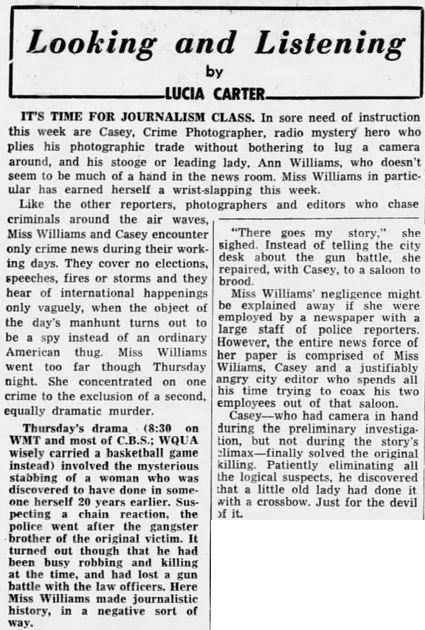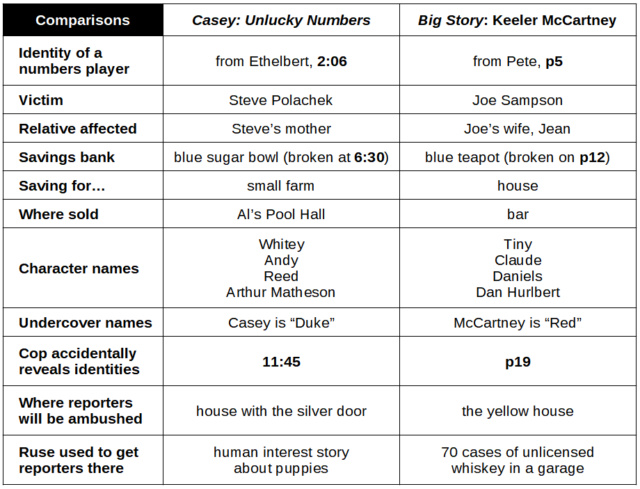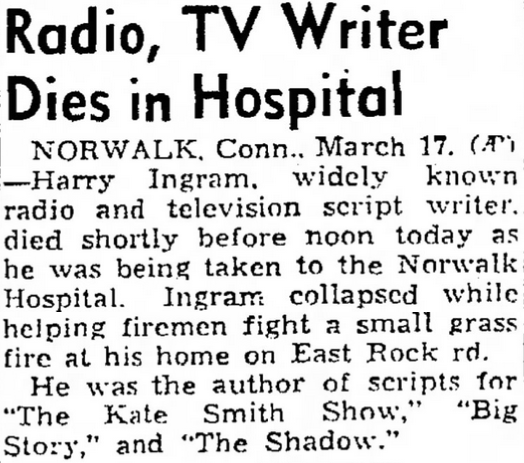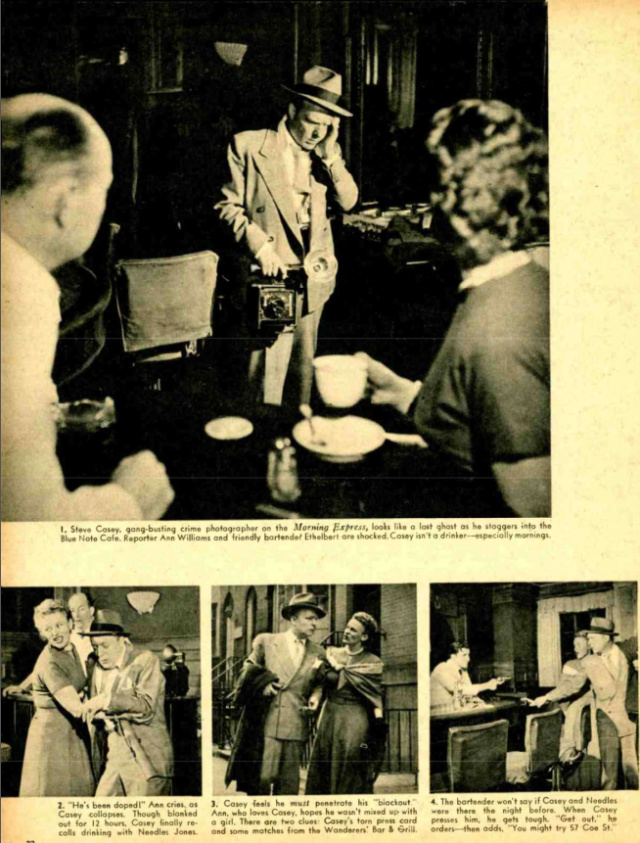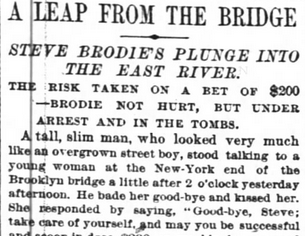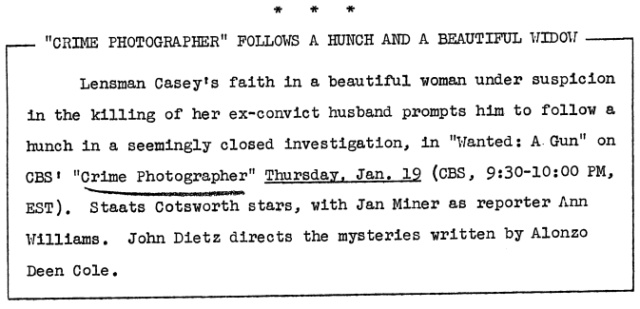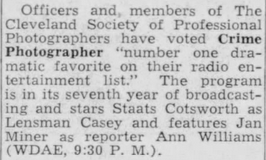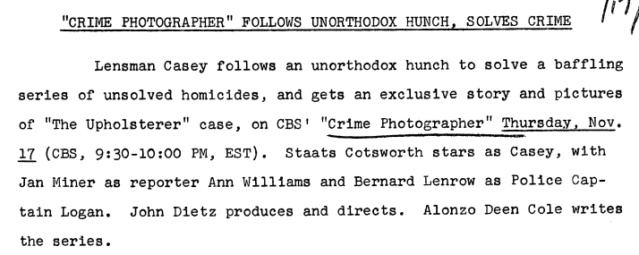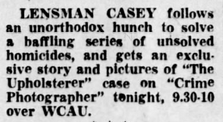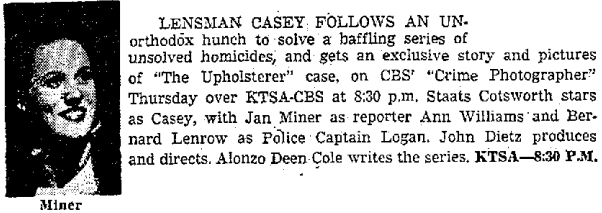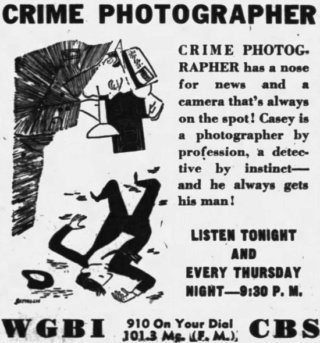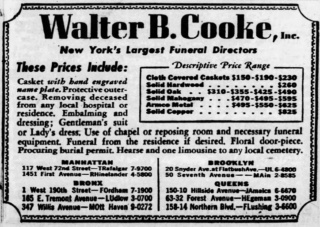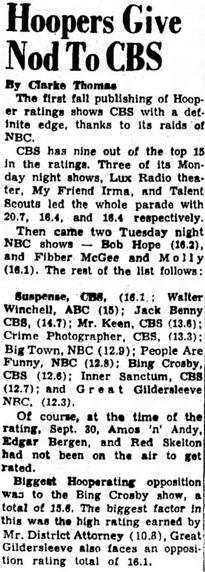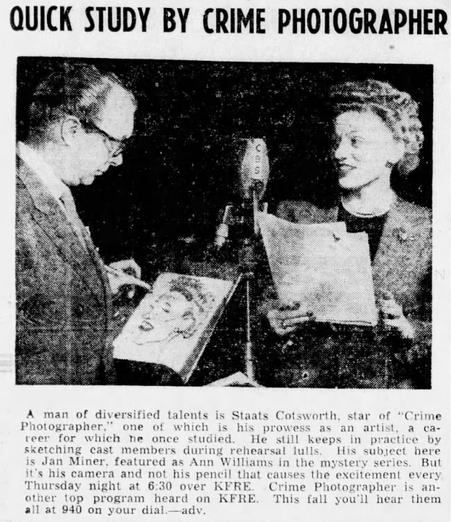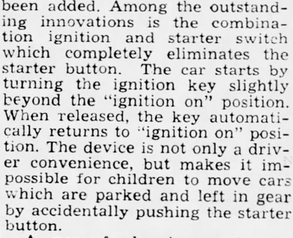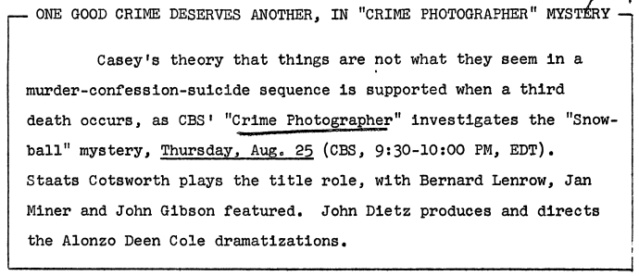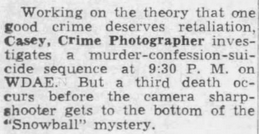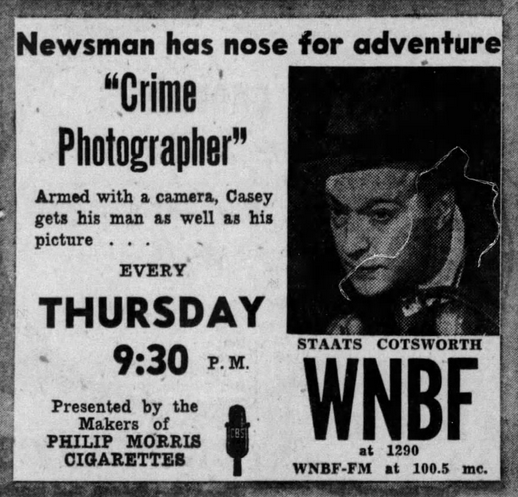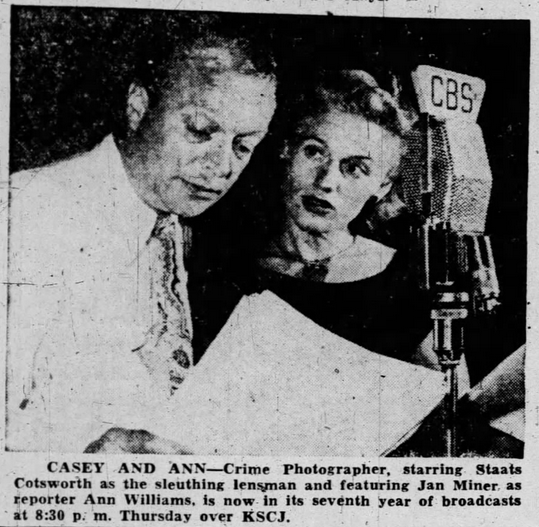Road Angel is the first of the revival series and is a below average Casey presentation.
The broadcast is interesting, however, for its use of the original
show opening from the early sustaining years and how the characters are
introduced to the audience through dialogue. Off the radio for 37
months, the listening audience had changed dramatically, with many new
listeners who needed to be familiar the characters, and returning
listeners who needed to be refreshed (and perhaps de-programmed from the
different characterizations of the television series). The big band
flourishes of the Anchor-Hocking period are long gone, and the lusher
orchestral arrangements of the Philip Morris era are replaced by organ
music, a staple of early radio and always of soap operas. The revival
could be viewed as a step down in show quality, which it was, but it
also reclaimed the innocence of earlier years of both radio drama in
general and Casey in particular.
There are no continuity notes for any of the revival series, nor are there any episode-specific news clippings.
1:10 Casey says hi to cops Charlie, Pete, Frank, and there is a group greeting in return. No clue why those names were picked by Cole, but they usually have some meaning to staff and others.
1:25 The murder victim (Pierce) has been shot with a .38; he was a sales representative, shot by a hitchhiker.
2:45 We hear Teddy Wilson for the first time in the drama portion of the program; he played along with Lew White's organ music at the show open. Ethelbert answers the phone "Blue Note Cafe, Ethelbert the Bartender speaking." New listeners get an intro to the character and the location.
3:15 Ethelbert asks Walter for a cup of coffee (for Casey) and to bring up more olives. Olives? Martinis, though a drink with a long history, had a surge of popularity in the mid-1950s; and this may have been a nod to that. Walter has no response. We do hear the sound effects of the coffee being delivered at 3:36.
4:55 Logan has fingerprints from the car of a known criminal, Flagler. It's a false lead.
6:10 Casey would like to take a ride to Clinton County to get away from things. This is another indicator that Casey's locale is New York City. The county is along the west shore of Lake Champlain and borders Canada. This was a popular area for summer homes on the lake or in the Adirondack Mountains. In the center of the county is the town of Dannemora, known for a 2015 prison escape that made national headlines and became a 2018 Showtime feature directed by Ben Stiller. It is one of the more remote parts of New York state, 300 miles from New York City, so it is unlikely that a pleasure trip for an afternoon would even be possible. https://en.wikipedia.org/wiki/2015_Clinton_Correctional_Facility_escape
10:00 Casey considers a theory of the case that Pierce survived a botched holdup by Flagler, but would pick up another hitchhiker if it was a woman, especially an attractive one.
11:40 Hite announces that On Stage is coming back in a new time slot; Casey has taken its time slot. The program, which starred Elliott and Cathy Lewis, resumed in early February.
12:30 Casey is up in Ardmore, described as "upstate." There is no such town in New York or New England.
13:15 Casey stops for gas after four days of picking up woman hitchhikers with no success in attracting the killer.
14:05 Casey gives his business card to the gas attendant in case he hears of anything about the hitchhiker. The attendant recognizes the name as the photographer for crime pictures. He mentions the Pierce killing; he knew Pierce as a regular customer. Casey is thinking of packing it in and purposely and sarcastically misquotes a line from Longfellow's The Day is Done https://www.poetryfoundation.org/poems/45896/the-day-is-done The attendant corrects him. It was common at the time that high school educated persons would have some familiarity with such literature at the time, so while amusing, it is not out of place. 14:50 The attendant knows of the "girl hitchhiker" and she robbed him. He never said anything because he was concerned about his reputation as a family man. He describes her for Casey... "an angel of the road." That is where the show title came from. He describes her gun as a snub-nose .38 revolver!
17:55 Casey finally spots the "road angel" and she gets into his car. She says her name is Doris Chapman. She is 21. They eventually get into small talk, all a ruse to gain Casey's confidence. She turns at 19:57 saying how much she hates men and makes Casey stop and get out. She takes the car and drives away.
20:55 Hours later, Casey is back with Ann and Logan, getting a good razzing from both of them. At least he has a good description of her ("I haven't been photographing people all these years without lookin' at 'em"). Logan thinks that Ann, knowing the description, can send her to find the "road angel" and win her confidence. She does, this time her name is "Doris Larkin." Ann plays it up that she's a tough grifter, too, and this time she wins Doris' confidence. Doris explains her tough family experiences. Ann scuffles in the car with Doris and takes her gun! Casey and Logan were following Ann's car (for four days... that's unlikely in real life to have a homicide captain out of the precinct for that long) and come running to get Doris and protect Ann. Ann had a recorder in the car hidden in the luggage, and was able to capture Doris' confession.
Lenrow (Logan) finally gets on-air credit as part of the regular cast.
Vox has an interesting brief history of hitchhiking. https://www.vox.com/2015/6/8/8737623/hitchhiking The practice was common in the Depression, and slowly declined as prosperity brought greater car ownership and declines in prices of long-distance travel.
Casey 54-01-13 368 The Road Angel (series returns to air).mp3
Degoo https://app.degoo.com/share/Zb6EoktBT4eSe4
hubiC http://ovh.to/fHq6U2b
There are no continuity notes for any of the revival series, nor are there any episode-specific news clippings.
1:10 Casey says hi to cops Charlie, Pete, Frank, and there is a group greeting in return. No clue why those names were picked by Cole, but they usually have some meaning to staff and others.
1:25 The murder victim (Pierce) has been shot with a .38; he was a sales representative, shot by a hitchhiker.
2:45 We hear Teddy Wilson for the first time in the drama portion of the program; he played along with Lew White's organ music at the show open. Ethelbert answers the phone "Blue Note Cafe, Ethelbert the Bartender speaking." New listeners get an intro to the character and the location.
3:15 Ethelbert asks Walter for a cup of coffee (for Casey) and to bring up more olives. Olives? Martinis, though a drink with a long history, had a surge of popularity in the mid-1950s; and this may have been a nod to that. Walter has no response. We do hear the sound effects of the coffee being delivered at 3:36.
4:55 Logan has fingerprints from the car of a known criminal, Flagler. It's a false lead.
6:10 Casey would like to take a ride to Clinton County to get away from things. This is another indicator that Casey's locale is New York City. The county is along the west shore of Lake Champlain and borders Canada. This was a popular area for summer homes on the lake or in the Adirondack Mountains. In the center of the county is the town of Dannemora, known for a 2015 prison escape that made national headlines and became a 2018 Showtime feature directed by Ben Stiller. It is one of the more remote parts of New York state, 300 miles from New York City, so it is unlikely that a pleasure trip for an afternoon would even be possible. https://en.wikipedia.org/wiki/2015_Clinton_Correctional_Facility_escape
10:00 Casey considers a theory of the case that Pierce survived a botched holdup by Flagler, but would pick up another hitchhiker if it was a woman, especially an attractive one.
11:40 Hite announces that On Stage is coming back in a new time slot; Casey has taken its time slot. The program, which starred Elliott and Cathy Lewis, resumed in early February.
12:30 Casey is up in Ardmore, described as "upstate." There is no such town in New York or New England.
13:15 Casey stops for gas after four days of picking up woman hitchhikers with no success in attracting the killer.
14:05 Casey gives his business card to the gas attendant in case he hears of anything about the hitchhiker. The attendant recognizes the name as the photographer for crime pictures. He mentions the Pierce killing; he knew Pierce as a regular customer. Casey is thinking of packing it in and purposely and sarcastically misquotes a line from Longfellow's The Day is Done https://www.poetryfoundation.org/poems/45896/the-day-is-done The attendant corrects him. It was common at the time that high school educated persons would have some familiarity with such literature at the time, so while amusing, it is not out of place. 14:50 The attendant knows of the "girl hitchhiker" and she robbed him. He never said anything because he was concerned about his reputation as a family man. He describes her for Casey... "an angel of the road." That is where the show title came from. He describes her gun as a snub-nose .38 revolver!
17:55 Casey finally spots the "road angel" and she gets into his car. She says her name is Doris Chapman. She is 21. They eventually get into small talk, all a ruse to gain Casey's confidence. She turns at 19:57 saying how much she hates men and makes Casey stop and get out. She takes the car and drives away.
20:55 Hours later, Casey is back with Ann and Logan, getting a good razzing from both of them. At least he has a good description of her ("I haven't been photographing people all these years without lookin' at 'em"). Logan thinks that Ann, knowing the description, can send her to find the "road angel" and win her confidence. She does, this time her name is "Doris Larkin." Ann plays it up that she's a tough grifter, too, and this time she wins Doris' confidence. Doris explains her tough family experiences. Ann scuffles in the car with Doris and takes her gun! Casey and Logan were following Ann's car (for four days... that's unlikely in real life to have a homicide captain out of the precinct for that long) and come running to get Doris and protect Ann. Ann had a recorder in the car hidden in the luggage, and was able to capture Doris' confession.
Lenrow (Logan) finally gets on-air credit as part of the regular cast.
Vox has an interesting brief history of hitchhiking. https://www.vox.com/2015/6/8/8737623/hitchhiking The practice was common in the Depression, and slowly declined as prosperity brought greater car ownership and declines in prices of long-distance travel.
Casey 54-01-13 368 The Road Angel (series returns to air).mp3
Degoo https://app.degoo.com/share/Zb6EoktBT4eSe4
hubiC http://ovh.to/fHq6U2b
